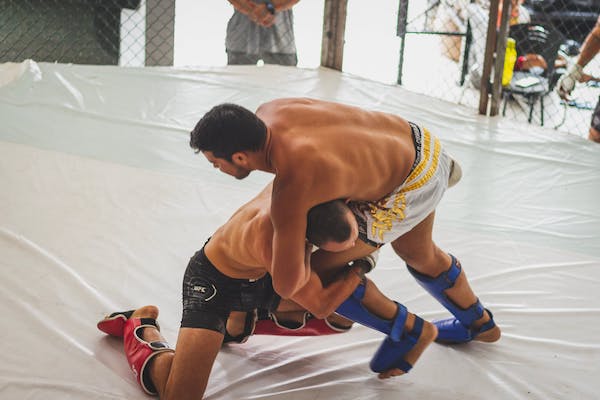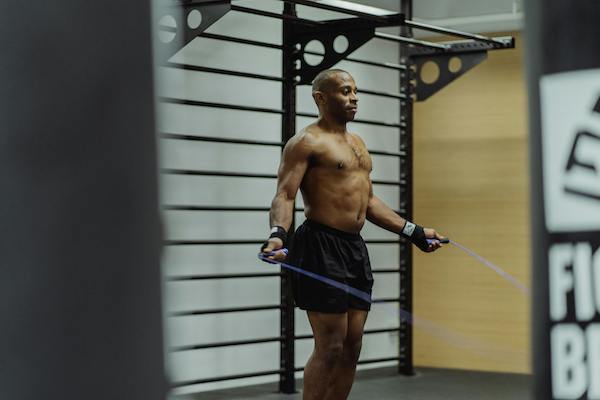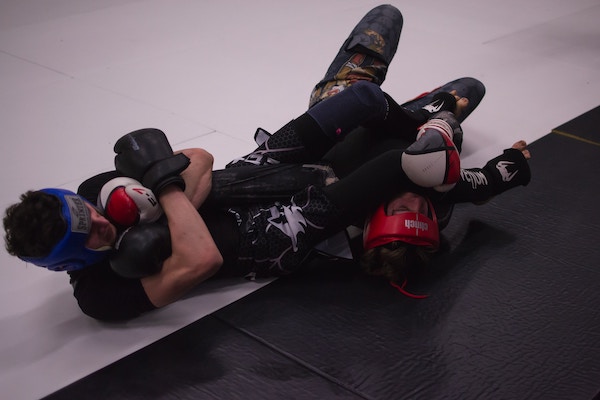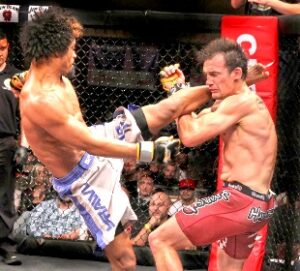
Are you wondering whether MMA is effective in a street fight?
In this article, we explain 9 reasons why MMA is effective in street fights and how it’s by far the best martial art for street fighting.
Contents
- Is MMA Effective In a Street Fight?
- 1. MMA Practitioners Are Well-Rounded Fighters
- 2. MMA Practitioners Learn and Use the Best Fighting Techniques
- 3. MMA Practitioners Have Excellent Cardiovascular Endurance
- 4. MMA Practitioners Continually Test Their Skills By Sparring
- 5. MMA Is Highly Competitive
- 6. MMA Practitioners Are Constantly Adapting To New Fighting Styles
- 7. MMA Practitioners Train In Different Gear and Clothing
- 8. MMA Practitioners Have a High Pain Tolerance
- 9. MMA and Street Fights Have The Same End Goal
- Reasons People Believe MMA Is Ineffective In Street Fights
- The Bottom Line
Is MMA Effective In a Street Fight?
In short, MMA is exceptionally effective in a street fight because MMA practitioners are well-rounded (striking, grappling, submissions), they have great cardiovascular endurance, they’re continually testing and improving their skills through sparring, and it’s very transferable to street fighting.
There are many more reasons why MMA is effective in a street fight, so let’s go through each.
1. MMA Practitioners Are Well-Rounded Fighters

Integration of Diverse Martial Arts: MMA is unique in integrating a wide array of martial arts styles, making its practitioners exceptionally well-rounded.
This variety equips fighters with a comprehensive skill set that allows them to defend and attack effectively in any direction a fight may take.
Skills range from a diverse array of strikes, adeptness in standing and ground grappling, and executing submissions.
MMA fighters have complete coverage of:
- Standup Striking: through Muay Thai, boxing, kickboxing, karate
- Standing Grappling/Clinching: through judo, Muay Thai, wrestling, sambo
- Ground Fighting: through wrestling and Brazilian jiu-jitsu
Covering these three makes MMA fighters versatile and prepared for any combat scenario. This is especially useful in street fights where the dynamics can swiftly shift.
Ideal for Unpredictable Street Fights: The foundational concept of MMA, which involves blending various striking and grappling techniques into a cohesive fighting style, is ideal for the chaotic nature of street fighting.
This approach ensures preparedness in standup confrontations, clinch situations, and ground engagements.
The ability to wrestle, strike, and apply chokes or joint locks in diverse combat scenarios makes MMA an incredibly versatile and effective discipline for the unpredictable nature of street fights.
2. MMA Practitioners Learn and Use the Best Fighting Techniques

Origin and Evolution of MMA Techniques: Since its inception, MMA, and specifically the UFC, was designed to identify the most effective martial arts techniques.
Early MMA formats, reminiscent of style-vs-style matchups, were akin to street fights with minimal rules, enabling a clear distinction between effective and ineffective martial arts.
Over time, styles like Brazilian jiu-jitsu, wrestling, Muay Thai, and kickboxing emerged as dominant due to their practicality in real combat.
This ongoing evolution has led to a sport where only the most effective techniques are learned and used – thus making MMA extremely effective in street fights.
Fast Adaptation Practical Techniques: MMA is dynamic, with techniques evolving and adapting to the demands of the sport.
For example, the calf kick, once a niche move, gained popularity after being successfully used in high-profile fights.
This adaptability ensures MMA practitioners are constantly updating their arsenal with practical and effective techniques, crucial for street fight scenarios.
3. MMA Practitioners Have Excellent Cardiovascular Endurance

Sustained Fighting Ability: In MMA, the rigorous training regimen incorporates multiple styles, requiring athletes to develop high aerobic and anaerobic capacities.
This development enables fighters to engage in prolonged combat with short explosive bursts of effort and maintain performance over extended periods.
The ability to fight effectively without fatiguing is a significant advantage in street fights, where endurance is often the deciding factor between two unskilled opponents.
MMA fighters develop excellent cardiovascular endurance through sparring sessions, wrestling and grappling drills, shark tank training, and regular specific cardiovascular conditioning such as running or jump rope.
4. MMA Practitioners Continually Test Their Skills By Sparring

Practice Under Real Combat Conditions: Sparring is the closest experience to an actual fight, providing a controlled environment for fighters to test and refine their techniques.
It enables practitioners to apply their skills in a setting that mimics real-world combat scenarios.
This regular practice helps fighters learn how to effectively combine offense and defense, crucial in the unpredictable dynamics of street fights.
Mental Preparation for Self-Defense: Sparring is also a mental exercise that prepares fighters for the psychological aspects of combat.
Many people freeze or panic in self-defense situations due to fear and adrenaline.
Regular sparring helps mitigate this by acclimatizing fighters to the stress and flow of combat, ensuring they remain composed and make rational decisions under pressure.
This mental readiness is vital in street fights, where quick thinking and emotional control are as important as physical strength and fighting skills.
Developing Muscle Memory: Through repetitive practice during sparring, fighters develop muscle memory for various techniques and reactions.
This ingrained response system is invaluable in real fights, where there’s little time to think.
Muscle memory ensures a fighter’s body automatically responds with appropriate techniques, making their defense and offense more instinctive and effective in chaotic street fight situations.
5. MMA Is Highly Competitive

Increased Competition: Due to MMA’s rapid growth, there’s a lot of money on the line for MMA fighters. This increases the number of people training in MMA, its competitiveness, the level of coaching, and everything else associated.
Essentially, a rising tide (money) lifts all boats (everything MMA), and MMA fighters/practitioners are becoming the most skilled in the world because of it.
This translates to its effectiveness in a street fight, especially compared to other martial arts.
Technological and Methodological Advancements: With increasing access to diverse training methods and the integration of scientific principles, biomechanics, and sports performance analysis, martial arts techniques are becoming more refined and effective.
This continual evolution ensures MMA remains at the forefront of practical and efficient combat training, directly benefiting its applicability in street fights.
6. MMA Practitioners Are Constantly Adapting To New Fighting Styles

Global Outreach and Diverse Talent Pool: The UFC’s ability to transcend geographical and cultural barriers has introduced MMA to audiences worldwide.
This global outreach has expanded the fan base and fostered a melting pot of fighting styles and techniques.
As a result, MMA practitioners are exposed to a broader range of fighting styles and strategies.
This enhances their adaptability and effectiveness in managing unpredictable street fight scenarios.
7. MMA Practitioners Train In Different Gear and Clothing

Practicality: MMA practitioners train, learn, and enhance their martial arts skills while wearing different gear and clothing – which is very beneficial for street fighting.
In Brazilian jiu-jitsu, judo, and sambo, they train with and without a gi.
This translates extremely well to street fights as MMA practitioners can execute takedowns, throws, and submissions no matter what clothing is worn by either fighter. They’re prepared for all scenarios.
Regarding striking, MMA practitioners are well versed in training with boxing gloves, Muay Thai gloves, MMA gloves, and without gloves.
They’re equally effective with all sizes and types of gloves and without them.
Mostly they’re using 4 oz MMA gloves, which translates well into street fighting as they don’t hinder striking, wrestling, or submissions.
Also, as MMA practitioners train with smaller gloves and without gloves, they have well-conditioned hands and wrists, meaning they’re likely to remain injury-free during a street fight.
This allows them to continue fighting without any issues.
However, if they did experience an awful hand injury during a street fight, they have many other skills and techniques that could easily win them the fight.
8. MMA Practitioners Have a High Pain Tolerance

Training In Many Martial Arts: MMA combines various martial arts such as Brazilian jiu-jitsu, wrestling, Muay Thai, boxing, and judo.
This blend means athletes must be prepared for the physical demands and potential pain associated with each of these disciplines, ranging from strikes, slams, throws, takedowns, and submissions.
While most martial arts involve pain to a specific part of the body, such as boxers receiving most punches to the head, MMA practitioners have to deal with pain all over the body – and not just in legal strike zones.
MMA practitioners also deal with illegal strikes such as eye pokes and groin strikes, two commonly used techniques in no-holds-barred street fights.
Also, compared to some traditional martial arts or sports like boxing, MMA uses minimal protective gear.
Fighters typically wear small 4-ounce gloves that offer less padding than traditional boxing gloves. This reduced protection can result in more direct impact during strikes, leading to higher pain levels.
Overall, MMA practitioners have a very high pain tolerance for pain all over the body.
This means they’re used to and able to continue pushing through pain to find a way to win. This is very helpful in a street fight.
9. MMA and Street Fights Have The Same End Goal

The End Goal Is Aligned: The way to win in MMA is to hurt your opponent. To knock them out, submit them, or deal more damage so that the judges score the fight in your favor.
This perfectly aligns with street fighting where there are minimal rules, and winning is achieved by hurting or controlling your opponent until they stop attacking you.
Contrast this to wrestling where the aim is to pin your opponent, or Muay Thai where submissions aren’t allowed and the fight stops when a fighter hits the ground.
Overall, MMA is effective in street fights because the end goal of dealing damage to an opponent is aligned.
Reasons People Believe MMA Is Ineffective In Street Fights
Despite the above reasons explaining how MMA is exceptionally effective in street fights, many still argue against it.
So, let’s go through the reasons people sometimes give when claiming MMA is ineffective in street fights.
1. MMA Doesn’t Teach Defense Against Deadly Weapons

It’s true that MMA doesn’t teach defense against deadly weapons.
However, if you believe an attacker to have a deadly weapon such as a knife, your first defense should be to run from the situation.
You should still run even if you have learned weapon defense in martial arts like kali or krav maga, as it’s just not worth the risk.
Training for self-defense against deadly weapons like knives is a specialized area that goes beyond typical martial arts training.
While some martial arts do incorporate defense techniques against weapons, specialized courses focused on self-defense against weapons are often more aligned with police and military training.
For this reason, it’s not really a valid response to say that MMA isn’t effective for street fights because it doesn’t teach defense against deadly weapons.
No matter your training, removing yourself from the situation is priority number one.
2. MMA Doesn’t Include Illegal and Dirty Techniques
It’s true that MMA doesn’t specifically train practitioners to learn illegal and dirty techniques, but MMA practitioners are well-versed in them.
They’re constantly being hit with eye pokes, groin strikes, and rabbit punches, so in a street fight, they’re more than capable of defending against those.
And when it comes to a trained MMA practitioner vs an untrained fighter in a street fight, the ease with which the MMA practitioner will sweep them aside, it won’t matter whether illegal techniques are used.
Do you really think a groin strike or a headbutt will change the fight? Definitely not. That’s if they can even land them before they’re either knocked out or on the ground getting choked out like a snake.
Do you really think an MMA fighter can’t direct a powerful kick to the groin or pull someone’s hair? These are the best fighters in the world and they’re more than capable of defending against and using dirty techniques.
Also, what’s faster, a teep kick to the stomach or biting someone’s arm? A right hook to the temple or trying to gouge someone’s eyes?
MMA practitioners wouldn’t use illegal techniques in a street fight because they’re slow and impractical.
3. MMA Isn’t Useful vs. Multiple Opponents
While MMA is a 1 vs. 1 combat sport, it’s just as useful and even better for fighting multiple opponents than any other martial art.
As mentioned before, MMA fighters are very knowledgeable about different fighting styles and techniques, meaning they’re smart enough to know that fighting outnumbered isn’t a smart move, no matter how skilled they are.
If outnumbered, there isn’t a specific martial art that’ll save you. And if there was, that martial art would be MMA because of its versatility and all the other reasons mentioned in this article.
4. Ground Fighting Can Make You Vulnerable In a Street Fight
The only time ground fighting can make you vulnerable in a street fight is if you’re outnumbered. But if you’re outnumbered, run away and don’t entertain a fight.
If it’s a 1 vs. 1 street fight and you have wrestling, sambo, and Brazilian jiu-jitsu in your arsenal through your MMA training, it would be advisable to use it.
It will allow you to control your opponent and do what you want with them. You can massively reduce the chances of being hit, use ground-and-pound and submissions, or simply control them until they verbally submit.
5. MMA Takes Longer To Learn
Becoming a proficient mixed martial artist does take longer than it would to become skilled in a single martial art like kickboxing or wrestling.
This may mean that MMA is less effective in street fights than other martial arts for 1 year after you start training.
However, if you want to be the most skilled and competent fighter, it’s going to take blood, sweat, and years.
Roughly 2 years after starting, MMA is by far the most effective martial art for street fighting.
The Bottom Line
Overall, it’s clear that MMA is very effective in a street fight. More effective than any other martial art one could learn.
MMA practitioners are skilled in standup striking, standing grappling, and ground fighting, which includes ground wrestling, striking, and submissions.
MMA practitioners also have excellent cardio, experience with many different fighting styles, and the very best fighting techniques, as well as regularly improve their skills and composure through sparring.
Lastly, MMA practitioners have a very high pain tolerance, they train in many different types and sizes of gear, MMA is aligned with street fighting in the goal of hurting an opponent, and the extreme competitiveness in MMA makes its practitioners levels above ordinary fighters.
If you need further proof of how effective MMA can be in a street fight, you can read our article on 13 MMA/UFC fighters in street fights.




